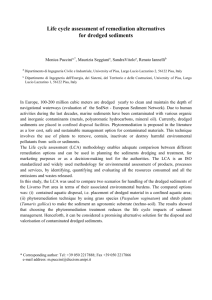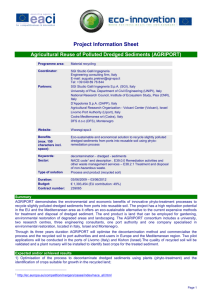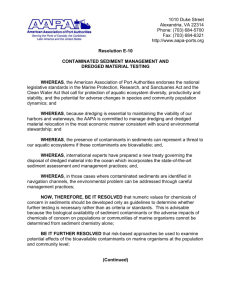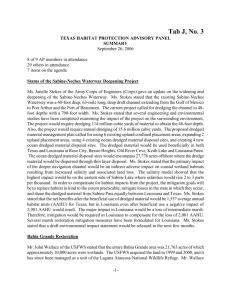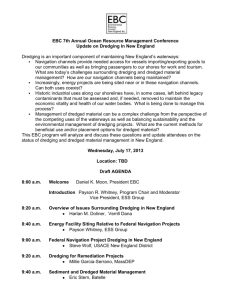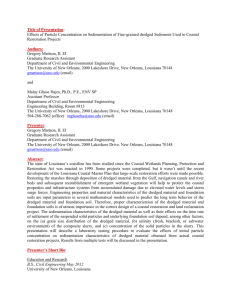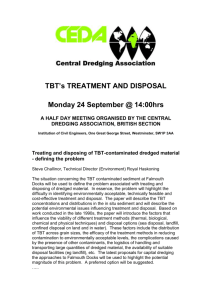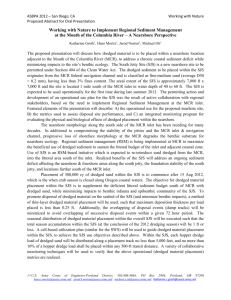Biodiversity Series
advertisement
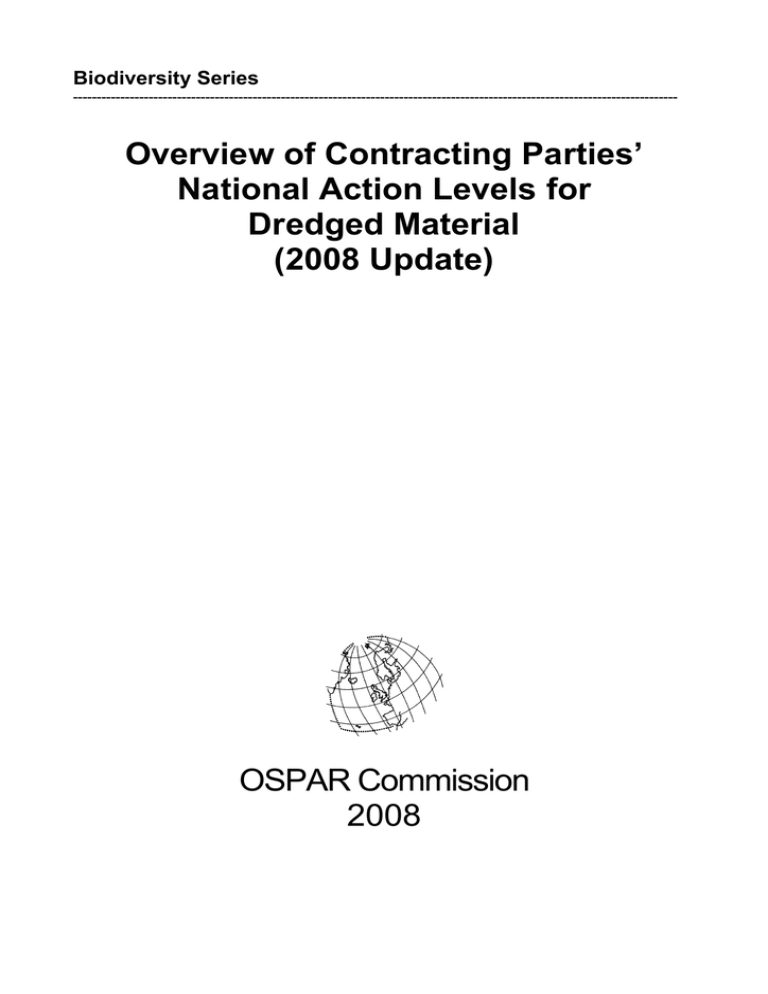
Biodiversity Series -------------------------------------------------------------------------------------------------------------------------------- Overview of Contracting Parties’ National Action Levels for Dredged Material (2008 Update) OSPAR Commission 2008 OSPAR Commission, 2008: Overview of Contracting Parties’ National Action Levels for Dredged Material _________________________________________________________________________________________________ The Convention for the Protection of the Marine Environment of the North-East Atlantic (the “OSPAR Convention”) was opened for signature at the Ministerial Meeting of the former Oslo and Paris Commissions in Paris on 22 September 1992. The Convention entered into force on 25 March 1998. It has been ratified by Belgium, Denmark, Finland, France, Germany, Iceland, Ireland, Luxembourg, Netherlands, Norway, Portugal, Sweden, Switzerland and the United Kingdom and approved by the European Community and Spain. La Convention pour la protection du milieu marin de l'Atlantique du Nord-Est, dite Convention OSPAR, a été ouverte à la signature à la réunion ministérielle des anciennes Commissions d'Oslo et de Paris, à Paris le 22 septembre 1992. La Convention est entrée en vigueur le 25 mars 1998. La Convention a été ratifiée par l'Allemagne, la Belgique, le Danemark, la Finlande, la France, l’Irlande, l’Islande, le Luxembourg, la Norvège, les Pays-Bas, le Portugal, le Royaume-Uni de Grande Bretagne et d’Irlande du Nord, la Suède et la Suisse et approuvée par la Communauté européenne et l’Espagne. © OSPAR Commission, 2008. Permission may be granted by the publishers for the report to be wholly or partly reproduced in publications provided that the source of the extract is clearly indicated. © Commission OSPAR, 2008. La reproduction de tout ou partie de ce rapport dans une publication peut être autorisée par l’Editeur, sous réserve que l’origine de l’extrait soit clairement mentionnée. ISBN 978-1-906840-02-0 Publication Number: 2008/363 2 OSPAR Commission, 20084: Overview of Contracting Parties’ National Action Levels for Dredged Material ______________________________________________________________________________________________ Introduction................................................................................................. 4 contents Annex 1 - Overview of Contracting Parties’ national action levels for dredged material............................................................................. 5 Belgium........................................................................................... 5 Denmark ......................................................................................... 5 Finland............................................................................................ 6 France ............................................................................................ 7 Germany......................................................................................... 7 Ireland............................................................................................. 9 The Netherlands ............................................................................. 9 Norway ......................................................................................... 10 Spain ............................................................................................ 11 Sweden......................................................................................... 11 United Kingdom ............................................................................ 12 Annex 2 - Approaches for Deriving National Action Levels...................... 13 Belgium......................................................................................... 13 Denmark ....................................................................................... 14 Finland.......................................................................................... 14 France .......................................................................................... 14 Germany....................................................................................... 14 Ireland........................................................................................... 15 The Netherlands ........................................................................... 15 Norway ......................................................................................... 16 Portugal ........................................................................................ 16 Spain ............................................................................................ 16 United Kingdom (England and Wales) ......................................... 16 Annex 3 - Overview of the Present Situation on Action Levels ................ 18 Annex 4 - Licensing procedures............................................................... 20 Belgium......................................................................................... 20 Denmark ....................................................................................... 20 Finland.......................................................................................... 20 France .......................................................................................... 20 Germany....................................................................................... 20 The Netherlands ........................................................................... 21 Norway ......................................................................................... 21 Spain ............................................................................................ 22 Sweden......................................................................................... 22 United Kingdom ............................................................................ 23 3 OSPAR Commission, 2008: Overview of Contracting Parties’ National Action Levels for Dredged Material _________________________________________________________________________________________________ Introduction This document compiles Contracting Parties’ national action levels, and includes a survey of the approaches used by Contracting Parties in order to help understand how action levels for dredged material have been derived by different Contracting Parties. Action levels represent sediment quality criteria for the management of dredged material. Most countries use a “3 category action level” approach which means that 2 concentrations are provided. Concentrations of contaminants in the material falling below the lower limit represent those of little concern. Those failing between the lower limit and the upper limit may trigger further investigation of the material proposed for dumping. Those concentrations above the upper value generally mean that dumping of the material at sea is not permitted. Where action levels have not been developed, a “case-by-case” approach is taken for each application considered individually. The report was produced by Belgium on the basis of contributions from Contracting Parties and complemented with information from a general background document prepared by the United Kingdom. It updates a report on national action levels that was published by the OSPAR Commission in 2004 (Publication No. 211). This report also has a value for those outside of OSPAR, and in particular the London Convention. The report consists of: a. b. c. d. 4 an overview of Contracting Parties’ national action levels for dredged material (Annex 1); an overview of national approaches for deriving national action levels (Annex 2); an overview of the present situation on action levels (Annex 3) which summarises current concentration ranges used by Contracting Parties in the assessment of dredged material for dumping at sea, and of the approaches used in dredged material assessment; an overview of national licensing procedures (Annex 4) which gives an overview of how action levels are used in the licensing procedures of Contracting Parties. OSPAR Commission, 2008: Overview of Contracting Parties’ National Action Levels for Dredged Material _________________________________________________________________________________________________ Annex 1 - Overview of Contracting Parties’ national action levels for dredged material Belgium The action levels used in Belgium are as shown in the following Table: Dry weight basis Action level 1 Action level 2 Hg Cd 0,3 ppm 2,5 ppm 1,5 ppm 7 ppm Pb Zn Ni As Cr Cu 70 ppm 160 ppm 70 ppm 20 ppm 60 ppm 20 ppm 350 ppm 500 ppm 280 ppm 100 ppm 220 ppm 100 TBT 3 ppb 7 ppb mineral oil 14 mg/goc 36 mg/goc PAKs 70 µg/goc 180 µg/goc PCBs 2 µg/goc 2 µg/goc Denmark The action levels used in Denmark are shown in the following table. The action levels were adopted 1st October 2005 by the Ministry of the Environment. Contaminant mg/kg d.w., if not otherwise stated Cu Hg Ni Zn Cd As Pb Cr TBT μg/kg PCB μg/kg1) PAH2) 1) 2) 3) Action level 13) 20 0,25 30 130 0,4 20 40 50 7 20 3 Action level 23) 90 1 60 500 2,5 60 200 270 200 200 30 Sum of the following 7 PCBs: 28, 52, 101, 118, 138, 153 and180. Sum of the following 9 PAHs: Anthracen, benz[a]anthracen, benz[ghi]perylen, benz[a]pyren, chrysen, fluoranthen, indeno[1,2,3cd]pyren, pyren og phenanthren. In Natura2000 areas and areas with a water depth less than 6-meters concentrations of metals and metalloids should be at background levels. 5 OSPAR Commission, 2008: Overview of Contracting Parties’ National Action Levels for Dredged Material _________________________________________________________________________________________________ Finland In Finland action levels became official in May 2004. They are guidance values, not binding norms and are as show in the following table: Contaminant Hg Cd Cr Cu Pb Ni Zn As PAHs Naphtalene Anthracene Phenanthrene Fluoranthene Benzo(a)anthracene Chrysene Benzo(k)fluoranthene Benzo(a)pyrene Benzo(ghi)perylene Indeno (123-cd)pyrene Mineral oil DDT + DDE + DDD PCB (IUPAC-numbers) 28 52 101 118 138 153 180 Tributyltin (TBT) Dioxins and furans (PCDD and PCDF) Action level 1 Mg/kg d.w. 0,1 0,5 65 50 40 45 170 15 Action level 2 Mg/kg d.w. 1 2,5 270 90 200 60 500 60 0,01 0,01 0,05 0,3 0,03 1,1 0,2 0,3 0,8 0,6 50 0,01 µg/kg d.w. 0,1 0,1 0,5 3 0,4 11 2 3 8 6 1500 0,03 µg/kg d.w. 1 1 4 4 4 4 4 3 Ng WHO-TEQ/kg 30 30 30 30 30 30 30 200 Ng WHO-TEQ/kg 20 500 All measured contaminant content are normalized to a “standard soil”-composition (10 % organic material and 25% clay). The values in the table refer to the normalized values. 6 OSPAR Commission, 2008: Overview of Contracting Parties’ National Action Levels for Dredged Material _________________________________________________________________________________________________ France In France the action levels are as shown in the following tables: (mg/kg d.w) Hg Cd As Pb Cr Cu Zn Ni PCB (mg/kg d.w) CB 28 52 101 118 180 138 153 Total PCBs Action level 1 Action level 2 0,4 1,2 25 100 90 45 276 37 0,8 2,4 50 200 180 90 552 74 Action level 1 Action level 2 0,025 0,025 0,050 0,025 0,025 0,05 0,05 0,5 0,05 0,05 0,05 0.10 0,05 0,10 0,10 1,0 Germany In Germany action levels 1 and 2 for trace metals and organic contaminants in dredged material in the coastal area of the North Sea (related to the sediment fraction < 20 µm, dry weight) are as shown in the following table: 7 OSPAR Commission, 2008: Overview of Contracting Parties’ National Action Levels for Dredged Material _________________________________________________________________________________________________ Action level 1 Action level 2 Arsenic Cadmium Chromium Copper Mercury Nickel Lead Zinc mg / kg mg / kg mg / kg mg / kg mg / kg mg / kg mg / kg mg / kg 30 2,5 150 40 1,0 50 100 350 150 12,5 750 200 5 250 500 1750 CB 28 CB 52 CB 101 CB 118 CB 138 CB 153 CB 180 Sum of 7 CBs µg / kg µg / kg µg / kg µg / kg µg / kg µg / kg µg / kg µg / kg 2 1 2 3 4 5 2 20 6 3 6 10 12 15 6 60 α - Hexachlorcyclohexane γ - Hexachlorcyclohexane Hexachlorbenzene Pentachlorbenzene p,p´-DDT p,p´-DDE p,p´-DDD µg / kg µg / kg µg / kg µg / kg µg / kg µg / kg µg / kg 0,4 0,2 2 1 1 1 3 1 0,6 6 3 3 3 10 mg/kg mg/kg 1 300 3 1000 1 PAH (Sum of 6 PAHs) hydrocarbons Action levels for tributyltin (TBT) in dredged material (in µg TBT/kg total sediment) from 2001 onwards are in Germany as in the following table: 1 8 Action level 1 Action level 2 Valid from year 20 600 2001 20 300 2005 20 60 2010 total of 6 PAH compounds: fluoranthene, benzo(b)fluoranthene, benzo(k)fluoranthene, benzo(a)pyrene, benzo(ghi)perylene, indeno(1,2,3-cd)pyrene OSPAR Commission, 2008: Overview of Contracting Parties’ National Action Levels for Dredged Material _________________________________________________________________________________________________ Ireland Action levels for disposal of dredged material in Irish waters were accepted in 2006 and shown in the following table: Arsenic Cadmium Chromium Copper Lead Mercury Nickel Zinc Units (dry wta) mg kg-1 mg kg-1 mg kg-1 mg kg-1 mg kg-1 mg kg-1 mg kg-1 mg kg-1 Σ TBT & DBT mg kg-1 0,1 0,5 γ – HCH (Lindane) HCB μg kg-1 0,3 1 μg kg-1 0,3 1 μg kg-1 1 180 μg kg-1 7 1260 PAH (Σ 16) μg kg-1 4000 Total extractable hydrocarbons g kg-1 1,0 Metric PCB (individual congeners ICES 7) PCB (ΣICES 7) of Lower level Upper levelb 9c 0,7 120 40 60 0,2 21 160 70* 4,2 370 110d 218 0,7 60 410 a total sediment <2mm b ERM (rounded up) c ERL (rounded up) – No background Irish data available d PEL as ERM considered high The Netherlands Since 2006, the following action levels are being used in the Netherlands. It should be remarked that after evaluation of the bioassay tests which were performed before, it was decided that they are not useful and are no longer considered as an accurate action level. 9 OSPAR Commission, 2008: Overview of Contracting Parties’ National Action Levels for Dredged Material _________________________________________________________________________________________________ Substance Tributyltin (TBT)3,5 Copper (Cu) Arsenic (As) 2 2 Cadmium (Cd) Mercury (Hg) 3 3 Chromium (Cr)2 Zinc (Zn) 2 Nickel (Ni) 3 Lead (Pb)3 Units MTR-action level ZBT-action level1 Organometal µg Sn/kg d.s. 0.000007 250 Metal mg/kg d.s. 36 60 Metal mg/kg d.s. 29 29 Metal mg/kg d.s. 0.8 4 Metal mg/kg d.s. 0.3 1,2 Metal mg/kg d.s. 100 120 Metal mg/kg d.s. 140 365 Metal mg/kg d.s. 35 45 mg/kg d.s. 85 110 Metal Sum 10-PAH’s 3 Omive Hexachlorobenzene Sum 3 DDT/DDD/DDE Mineral oil C10-40 Sum 7-PCB’s Group 2 3 4 8 mg/kg d.s. Omive µg/kg d.s. 0.05 20 Omive µg/kg d.s. 0.05 20 Oil mg/kg d.s. 0.01 0.02 Omive µg/kg d.s. 50 1250 3 0.1 1. Without standard soil correction 2. 50% ZBT-judging rule; for no more than two non priority substances and excession of the action level is allowed with no more than 50 % per substance. 3. ZBT: these priority substances are tributyltin, cadmium, mercury, nickel, lead, sum 10-PAH’s, sum 7PCB’s, sum DDT/DDD/DDE and hexachlorobenzene. The action level is valid as a hard upper level. 4. Omive: organic micro pollution. 5. For all Wvz permits an upper limit of 115 µg Sn/kg d.s. is valid. Norway The Norwegian action levels are based on analysis of whole sediment samples in the 0-2 cm upper fraction. This is often the most polluted fraction in Norwegian sediments. From Norwegian information from ’96 it seems that Norway does not work with the same system of action levels. The sediment is put into three categories (good/fair; poor/bad; very bad) without making being explicit how this assessment is used in the permit procedures. Parameter Metals (ppm dry weight) Arsenic Lead Fluoride Cadmium Copper Mercury Chromium Nickel Zinc Silver 10 Category 1 good/fair (class I&II) Category 2 poor/bad (class III&IV) Category 3 very bad (class V) < 20 - 80 < 30 - 120 < 800 - 3.000 < 0.25 - 1 < 35 - 150 < 0.15 - 0.6 < 70 - 300 < 30 - 130 < 150 - 700 < 0.3 - 1.3 80 - 1.000 120 - 1.500 3.000 - 20.000 1 - 10 150 - 1.500 0.6 - 5 300 - 5.000 130 - 1.500 700 - 10.000 1.3 - 10 > 1.000 > 1.500 > 20.000 > 10 > 1.500 >5 > 5.000 > 1.500 > 10.000 > 10 OSPAR Commission, 2008: Overview of Contracting Parties’ National Action Levels for Dredged Material _________________________________________________________________________________________________ Organic component (ppb dry weight) Sum PAH2 B(a)P3 Sum PCB4 HCB5 EPOCI6 2, 3, 7, 8-TCDD eqv.7 < 300 - 2.000 < 10 - 50 < 5 - 25 < 0.5 - 2.5 < 100 - 500 < 0.03 - 0.12 2.000 - 20.000 50 - 500 25 - 300 2.5 - 50 500 - 15.000 0.12 - 1.5 > 20.000 > 500 > 300 > 50 > 15.000 > 1.5 Spain 12. In Spain the concentrations are referred to fine fractions (< 63µm). Action levels are as follows: ppm d.w. Action level 1 Action level 2 Hg Cd Pb Cu Zn Cr As Ni S 7 PCBs* 0,6 1,0 120 100 500 200 80 100 0,03 3,0 5,0 600 400 3000 1000 200 400 0,1 * Sum of congeners n° 28, 52, 101, 118, 138, 153 and 180 Sweden In Sweden, action levels are based on the following background concentrations without providing information on the possible link between these concentrations and action levels: As Pb Fe Cd Co Cu Cr Hg Ni Sn V Zn 2 3 4 5 6 7 Background value (mg/kg dry weight) 10 10 40.000 0,3 15 20 20 0,1 15 1 20 125 Polycyclic aromatic hydrocarbons (EPA 16) Benzo(a)pyrene Polychlorinated biphenyls Hexachlorobenzene Extractable persistent organic chlor Total toxicity potential for polychlorinated dibenzofurans/dioxins, given as equivalents of the most toxic of these components (2, 3, 7, 8-tetrachlordibenzo-p-dioxin). 11 OSPAR Commission, 2008: Overview of Contracting Parties’ National Action Levels for Dredged Material _________________________________________________________________________________________________ United Kingdom The following table includes an overview of existing and revised action levels for all recorded determinants. The existing action levels were used as guideline action levels. It should be noted that the revised action levels have not been formally adopted yet. Contaminant, Existing Action level 1 mg,kg-1 (ppm) Existing Action level 2 mg,kg-1 (ppm) Revised Action level1 mg,kg-1 (ppm) DRY WEIGHT Revised Action level 2 mg,kg-1 (ppm) DRY WEIGHT Arsenic (As) Cadmium (Cd) Chromium (Cr) Copper (Cu) Mercury (Hg) Nickel (Ni) Lead (Pb) Zinc (Zn) Tributyltin (TBT,DBT,MBT) Polychlorinated Biphenyls (PCBs) Polyaromatic Hydrocarbons Acenaphthene Acenaphthylene Anthracene Fluorene Naphthalene Phenanthrene Benzo[a]anthracene Benzo[b]fluoranthene Benzo[k]fluoranthene Benzo[g]perylene Benzo[a]pyrene Benzo[g,h,i]perylene Dibenzo[a,h]anthracene Chrysene Fluoranthene Pyrene Indeno(1,2,3cd)pyrene Total hydrocarbons Booster Biocide and Brominated Flame Retardants * 20 0,4 40 40 0,3 20 50 130 50-100 2 400 400 3 200 500 800 20 0,4 50 30 0,25 30 50 130 70 4 370 300 1,5 150 400 600 0,1 1,0 0,1 0,5 0,02 0,2 0,02 0,18 0,1 0,1 0,1 0,1 0,1 0,1 0,1 0,1 0,1 0,1 0,1 0,1 0,01 0,1 0,1 0,1 0,1 100 100 - - - * Provisional Action levels for these compounds are subject to further investigation. 12 - OSPAR Commission, 2008: Overview of Contracting Parties’ National Action Levels for Dredged Material _________________________________________________________________________________________________ Annex 2 - Approaches for Deriving National Action Levels Belgium The assessment of the ecotoxicological acceptability of the dumping of dredged material into the North Sea has to be based upon quantitative action levels which must comply with the following stipulations. They have to be: a. b. c. manageable in practice; scientifically founded; realistic in practice The scenario is based on: a. an action level 1 (AL1 = target value) which enables, if it is fulfilled, the dumping of dredged material into the North Sea. This criterion depends on a “safe concentration” and on the partition coefficients of the contaminants; b. a limit value (AL2) which prohibits, if being exceeded, the dumping of dredged material into the North Sea. This criterion is based on a number of parameters of which the specification is part of this study; c. the presence of a “grey zone” between these two values of which the decision concerning the ecotoxicological acceptability can be based on e.g. bio-assays or limiting conditions. In order to fulfill this approach a study was carried out. Its methodology is given below and more detailed information can be found in EIHA 03/2/Info.3: a. A first important phase concerned the investigation of different methodologies which were applied in the scientific world for obtaining action levels. Furthermore these methodologies have been evaluated with regard to their utility for the siting of dredged material dumping in the North Sea. Based on the analysis of these different methodologies, the equilibrium partitioning method (EV) has been selected. In addition, further study has been carried out concerning the different parameters which are of importance in establishing action levels, namely the ecotoxicological characteristics as well as the partition of pollutants between the different phases in sediment. b. Firstly a detailed description has been drafted of the mechanisms relevant to the partitioning of pollutants between the different phases in sediments, because this is of primarily importance to the bioavailability of pollutants in sediments. To that aim, distinction has been made between anorganic pollutants, including heavy metals and organic pollutants such as PAHs, PCBs, TBT compounds and mineral oil. Based on this analysis, partition coefficients for the different pollutants were eventually selected from literature as well as from analyses of the sediments concerned. c. In addition, the ecotoxicological basis necessary for the development of action levels has been studied. Primarily, the ecotoxicity data relevant for the drafting of the so-called “exotoxicological value” or “safe concentration” were studied. Literature shows that to this aim it is possible to use water-only ecotoxicity data. Therefore, such ecotoxicity data were collected from literature for the different pollutants. In addition, a detailed summary has been given of the different methods used to obtain such an “ecotoxicological value”, also called “water quality criterion”. Based on existing ecotoxicity data, one of these methods has been applied to determine this value for each of the pollutants concerned. d. Subsequently, in order to avoid discrepancies between the safe ecotoxicity values and the background values, the natural background concentrations of the concerned pollutants both in seawater and in sediments were studied. Where necessary, adaptations of the derived action levels to these background concentrations are carried out. e. Finally, in view of the protection of higher organisms such as sea birds and man, an evaluation of the ecotoxicological value has been carried out as function of bioaccumulation and biomagnification. If necessary, based on that evaluation, a second adaptation of the derived action levels is carried out. 13 OSPAR Commission, 2008: Overview of Contracting Parties’ National Action Levels for Dredged Material _________________________________________________________________________________________________ Denmark The Danish action values have been based on data from the Netherlands and Finland. Some adjustments to Danish circumstances have been made. The lower action levels correspond to background levels or levels of expected no-effect. The upper action levels are based on international recognised levels, which means that ecotoxicological data are taken into account. Finland The national criteria were initially based on data from the Netherlands but some justifications have also been made. For metals level 1 is set by multiplying the natural background level by 1.5, except for Hg by 2.5. the level 2 has, in general, been set by using ecotoxicological data. Natural background levels have, however also been taken into account. For PAH’s level 2 is set by using ecotoxicological data and level 1 is calculated by dividing level 2 by 10. Action levels for DDT and PCB have relied very much on data from the Netherlands. For DDT level 1 equals detection limit. For dioxins and furans the action level 1 represent concentrations of unloaded areas and level 2 is estimated on the basis of human health risk. For TBT action level 1 represents detection limit. Action level 2 is originally determined by multiplying so called natural background level from Archipelago Sea by 5. France All existing data (between 1986 and 1990) from French harbours were collected: in total 445 data files. The data were collected with the double aim of: a. obtaining overall information on the distribution of heavy metals and PCBs in dredged material; b. defining action levels (a reference level and a limit level) for heavy metals and PCBs. The data were plotted in Gaussion mathematical curves. For each heavy metal were calculated: the value resulting from the extrapolation till 95% of the rectilinear part of the distribution curve (X95) and the median (Md). On the basis of the X95 and MD the following reference values for heavy metals were defined: a. the geological background value for metals, it was considered that the X95 value was representative for this background value; b. a level 1; it was adopted that the level 1 would equal 2 times the Md value c. a level 2; it was adopted that the level 2 would equal 4 times the Md value. A different approach was held for PCBs since they have an exclusive anthropogenic origin. A geological background value therefore could not be defined because it does not exist. Level 2 for PCBs was then defined on the basis of the value for fish consumption for fishes living at the disposal site. By homology with the relation between level 1 and level 2 for heavy metals, level 1 was then defined as half the value of level 2. Germany The national action levels 1 and 2 applied to dredged material from German federal waterways for trace metals and organic contaminants represent "management" values. They have been introduced in 1992 and 1997, respectively. The action levels are neither ecotoxicological quality criteria nor quality targets. These action levels are not applied to dredged material from waters under the responsibility of the federal states (Länder). Basis for the definition of action levels: 14 a. Quality criteria are derived from contaminant concentrations in North Sea wadden sediments. For trace metals, reference data are from 1982 - 1987, and for organic contaminants from 1989 - 1992. b. The reference values for trace metals equal the mean concentrations cm multiplied by a factor of 1,5 in order to take into account accidental uncertainties due to sampling and chemical analysis. All concentrations of trace metals refer to the fraction <20 µm. c. The reference values for organic contaminants correspond to the 90 percentile value of concentrations that were measured in the whole sample, i.e. <2 mm, and normalised to the fraction <20 µm. OSPAR Commission, 2008: Overview of Contracting Parties’ National Action Levels for Dredged Material _________________________________________________________________________________________________ Action levels are defined as below: action level 1 = reference value action level 2 = reference value * 5 for trace metals action level 2 = reference value * 3 for organic contaminants The action levels for trace metals and organic contaminants are under revision, and harmonisation between the federal authorities and the federal states is in process. TBT For TBT, action levels were implemented in 2001. They are agreed between the Federal Authorities and those of the federal states (Länder) and are applicable to dredged material from all coastal waterways. The implementation of action levels is tiered in three phases according to the schedule of IMO for the ban of TBT in antifouling coatings of ships, although with a time lag of two years. Action level 1 for TBT is ecologically oriented, and takes into consideration the lowest effect concentration (LOEL) observed for snails in the marine area. Whereas action level 1 remains constant over time, action level 2 decreases with time. For the short and medium term, the upper action level 2 takes into consideration the existing contamination and the technical and economic possibilities to reduce the TBT load in dredged material. In addition, reduction of TBT contamination in coastal waters should be promoted. In the long run, an action level 2 will be introduced, which is based on the assumption of a total ban of TBT in antifouling paints. Ireland The Republic of Ireland has developed Action Levels for use in Dredged Material assessment as required by OSPAR guidelines for the management of Dredged Material and entered into force in 2006. Assessment for suitability of dredge spoil in Ireland uses a 3 phase approach. Phase 1 is based on critical assessment of existing available literature and data. Phase 2 uses sediment chemistry criteria. The lower action level was set using 95%ile of background data, where applicable. In the absence of comparable data for sediments from Irish waters, the upper level has been set using ecotoxically derived values from other countries. Phase 3 comes into effect if the lower or upper guidance levels are judged to have been significantly exceeded, either in concentration, or in a number of categories. Assessment is carried out using a weight of evidence approach, and involves the use of appropriate toxicity tests eg whole sediment bioassay, microtox etc, as well as further sampling and chemical analysis in order to delineate a problem area. The Netherlands Target levels (level 1) are either the negligible concentration or the natural background level in the case the latter is higher than the former. This value is to be reached before the year 2010. For the North Sea however background values prevail above the calculated negligible concentration also in case these are lower than the negligible concentration. The precautionary principle and the stand still principle are at the basis of this policy decision. Basis for level 2 Prior to 1993, there was a separate set of quality criteria for dredged material from the Western Scheldt, the Wadden Sea and the North Sea. The set of quality criteria which was used for the North Sea was derived from the data on the distribution of pollutant concentrations in the sediments from the four dredging areas in 1988. These quality data were standardised to a normal soil type and a weighted 99 percentile was calculated for each of the four areas. The reference concentration for soil was added to this set of four concentrations and the highest number of the set of five was selected as a quality criterion. In 1994 the quality criteria for dredged material were harmonised and one uniform set of quality criteria remained for the Western Scheldt, the Wadden Sea and the North Sea. The Uniform Quality Criteria for Dredged Material have been set in such a way that the marine environment is protected from marine disposal of material with a high level of contamination, while the generation of excessive amounts of dredged material that need to be stored in special facilities is avoided. In 1994, 1998 and 2006 the uniform quality criteria were decreased/changed for several contaminants. 15 OSPAR Commission, 2008: Overview of Contracting Parties’ National Action Levels for Dredged Material _________________________________________________________________________________________________ During 1998 several aspects were investigated: standard operation procedures (SOP) and a quality assurance system for bioassays with salty dredged material and the first ring test was conducted. In the period 1999-2000 other discussions on policy aspects and systematic monitoring (bioassays and chemistry) of marine dredged material by RWS in harbours and shipping channels along the Dutch coast. This biological assessment system is since 2006 considered as useless and is not a part anymore of the judgement system. It is also important to note that dredged material is no longer regulated as a pollutant. Sediment is considered as a natural and valuable part of the water system. From this view point it does not make much sense any longer to judge each part of dredged material or whether it is possible to dump dredged material in the marine environment. Instead of this a monitoring system is foreseen which surveils the quality of the watersystem and also with a view to (other) user functions and quality objectives. Norway The Norwegian regulation on dumping activities (1980) is general and hasn’t been changed. Dredging and dumping is managed on a case by case basis. The Norwegian sediment criteria for Classification of Environmental Quality and Degree of Pollution is the basis tool for managing dredging and dredged material. These criteria are not, however, made for this purpose and some adjustments and simplifications are therefore made. Environmental Quality is described in five categories (classes) where class 1 represents what is believed to be a normal situation (slightly polluted) in an area without any point source. Class 5, to the contrary, represent an extremely polluted location. Various action levels are proposed for sediments of different classes in regard to dredging and dumping respectively. More than one option is normally possible for every case. Portugal No information from Portugal was received by Belgium. A UK report (October 2003) states that “Quality criteria standards determine the method for disposal of the dredged material. A 5-category approach is used to classify material for disposal, from Class 1 (may be disposed of in the aquatic medium or at places exposed to erosion or used to feed beaches without restrictive norms) through to Class 5 (should not be dredged).” Spain The action levels are based on the results of a number of studies related to: background values in Spanish coastal sediments; anthropogenic load in dredged material; normalisation techniques; validation of bioassay techniques; and bioavailability of contaminants in material dredged from different places. The following additional information derived from UK report (October 2003):“The Spanish recommendations were enacted by CEDEX in 1994 and are expected to be legally implemented towards the end of 2002. Standards apply to fine sediments (<63um) with more than 10% organic matter using a 3-category approach. Sediments with metal concentrations above the second level and = 8x Level 2, have to be isolated and belong to category IIIa. Sediments with metal concentrations higher than 8x level 2, must be isolated into containers or into a close space (category IIIb). Locally-derived background concentrations are under development. Bioassays are under development for application to dredge material assessment are Microtox, Ampelisca or Corophium and Arenicola.” United Kingdom (England and Wales) Internal guideline action levels were already in existence and what follows gives the review of these levels against some ecotoxicological data being available. Approach for metals Action levels for metals in dredge material applications in England and Wales have been reviewed. (There already existed guideline action levels). A nominal “background” concentration, based on sediment 16 OSPAR Commission, 2008: Overview of Contracting Parties’ National Action Levels for Dredged Material _________________________________________________________________________________________________ chemistry, was used in derivation of Action Level 1. Ecotoxicological data, based largely on datasets from the US, was used to guide the setting of Action Level 2. Changes in existing, internal guidelines for Action Level 1 have been proposed – a reduction in value for copper and mercury, and an increase in the value for chromium and nickel. Reductions in the guideline Action Level 2 have been proposed for all the metals under consideration. Approach for TBT The revision of Action Levels for TBT in dredged material has been completed using both chemical data for the DAS database and Ecotoxicological data derived from the peer reviewed literature. No change was made to Action Level 1 for TBT as this was deemed to be a suitable level at which primary anthropogenic impact can be detected; The value was taken from chemical data only. Action Level 2 was revised in line with current ecotoxicological data applied to the current DAS dataset. Approach for PAHs 32. The Action Level 1 values proposed by the UK have been set so as to trigger further study in a proportion of the samples analysed. The proposed Action Levels are thought to be relatively strict but this is considered to be justified under the precautionary approach. Current research is directed towards the use of sediment bioassays to assess toxicity directly. The limited knowledge of sediment PAH toxicity has precluded the derivation of Action Level 2. Approach for PCBs The approach to the derivation of PCB action levels has relied heavily on the toxicological data from the US and Canada since there is a significant lack of UK focused bioassay data which have been included UK marine species and this is considered to be a limiting factor in the refinement of Action Levels for the use in the marine environment. 17 OSPAR Commission, 2008: Overview of Contracting Parties’ National Action Levels for Dredged Material _________________________________________________________________________________________________ Annex 3 - Overview of the Present Situation on Action Levels 1. Summary of current concentration ranges used by Contracting Parties in the assessment of dredged material for dumping at sea Contaminant As Cd Cr Cu Hg Ni Pb Zn TARGET VALUES (“action level 1”) in <2 mm fine fractions fraction (<63 µm and 20 µm) Units mg kg –1 mg kg –1 mg kg –1 mg kg -1 mg kg –1 mg kg –1 mg kg –1 mg kg -1 20 - 80 0,4 - 2,5 40/50- 300 20 - 150 0,3/0,25- 0,6 20/30 - 130 50 - 120 130 - 700 30 - 80 1 - 2,5 150 - 200 40 - 100 0,6 - 1 50 - 100 100 - 120 350 - 500 LIMIT VALUES (“action level 2”) in <2 mm fine fractions fraction (<63 µm and 20 µm) 29 - 1000 2,4 - 10 120- 5000 60 - 1500 0,8 - 5 45 - 1500 110 - 1500 365-10000 150 - 200 5 - 12,5 750 - 1000 200 - 400 3-5 250 - 400 500 - 600 1750 - 3000 The exercise had only been done for heavy metals because the variability of organic pollutants chosen does not allow to make the exercise properly. Background values from Sweden have not been considered, since they are not linked to action levels. 2. Summary of approaches used in dredged material assessment by OSPAR Contracting Parties Country General approaches used Action level Notes No. categories in action level approach 3 Belgium Denmark Finland Action level Case-by-case 3 3 France Germany Action level Action level 3 3 Portugal Action level and case-by-case Action level 5 Netherlands 18 1 limit level Methods used in development of action levels 1) Sediment chemistry 2) Bioassays Sediment chemistry Sediment chemistry Background values Sediment chemistry 1) Sediment chemistry 2) Bioassays sediment chemistry Sediment chemistry Action levels based on mean contaminant concentration in marine navigation channels + scientific study Guidance values, not binding OSPAR Commission, 2008: Overview of Contracting Parties’ National Action Levels for Dredged Material _________________________________________________________________________________________________ Country General approaches used Notes No. categories in action level approach Action level + case5 by-case Action level 3 Methods used in development of action levels --- Spain Action level 3 Sediment chemistry Sweden UK Case-by-case ? England and Wales (E+W) and Scotland: Case-bycase approach. ----- ----- Norway R. of Ireland --- Sediment chemistry Bioassays Sediment chemistry not yet implemented in law. Sediment bioassays under development E+W: Under review. 3category action level approach in preparation. Scotland: Data assessed against OSPAR BRCs 19 OSPAR Commission, 2008: Overview of Contracting Parties’ National Action Levels for Dredged Material _________________________________________________________________________________________________ Annex 4 - Licensing procedures This section gives an overview of how action levels are used in the licensing procedures of Contracting Parties. Belgium If the analysis results exceed the value of action level 2 for three of the contaminants at the same time, the dredged material may not be dumped at sea. The result of the analysis is the numerical average of ten analyses. If the result lies between action level 1 and action level 2, the number of samples has to be increased by five and new analyses should to be carried out. If the new analysis results confirm the previous ones, then bioassays prescribed at international level have to be conducted. Negative results from these bioassays may lead to a ban on dumping dredged material from these delimited areas at sea. If all analysis results are lower than action level 1, the material may be dumped at sea. Denmark If chemical analysis of the material to be dumped shows concentrations below the lower action levels a permit for dumping can be given without further specific evaluations - taking into account proper site selection. If the chemical analysis shows concentrations of contaminants between the two action levels a more comprehensive study and evaluation has to be carried out, based on the amount to be dumped and the concentrations of contaminants. If the chemical analysis shows concentrations above the upper action levels dumping at sea will normally not be permitted, pending a throughout evaluation of the case, and the material must be deposited at land. Besides the evaluation based on chemical concentrations an evaluation of the amount of contaminants especially TBT and copper - are also carried out. Finland When the concentration content is under action level 1 dredged material is classified as “clean” and dumping of dredged material is allowed. When the concentration is above action level 2 the dredged material is considered contaminated and may not be dumped to the Baltic Sea. Between action levels 1 and 2 there is a “grey” zone where further studies are needed and decision is made on case-by-case basis. France If analysis shows that concentrations are less than action level 1, a general permit is given without specific study. If analysis shows that concentrations exceed action level 2, dumping at sea may be prohibited, especially when this dumping does not constitute the least detrimental solution for the environment (particularly with respect to other solutions, in situ or on land). These values do not consider the toxic character and the bioavailability of each element. If analysis shows that concentrations are situated between action level 1 and action level 2, a more comprehensive study might be necessary. The content of these studies will be established on a case by case basis in function of the local circumstances and the sensibility of the environment. Germany If analysis shows that concentrations are less than action level 1, the material is considered to be uncontaminated or slightly contaminated, and only the physical impact of the dumping should be taken into account. 20 OSPAR Commission, 2008: Overview of Contracting Parties’ National Action Levels for Dredged Material _________________________________________________________________________________________________ If analysis shows that concentrations (for at least one contaminant) are situated between action level 1 and action level 2, the material is considered to be moderately contaminated. In this case the following elements have to be taking into account before issuing a special permit: - It has to be checked, whether sea disposal is, compared to land disposal, the option of least detriment. - A source-reduction programme has to be planned, where there is a source to reduce. - The impact of the dumping operation has to be diminished as far as possible, e.g. by the use of containment or treatment methods. - A detailed impact hypothesis has to be prepared. - A monitoring programme at the disposal site and its surroundings has to be initiated. If analysis shows that concentrations (for at least one contaminant) exceed action level 2, the material is characterised as considerably contaminated. In this case, to mitigate the impact, additional steps should be considered. For each disposal option (either in coastal waters or alternatively at land) a comparative assessment should be carried out, of - the technical treatment of the dredged material; - human health risk; - hazard (including accidents) associated with treatment, transport and disposal; - economics including energy costs and costs for environmental protection; - exclusion of future uses of disposal areas. If the assessment shows a land alternative to be more acceptable, sea dumping should not be permitted. The Netherlands The evaluation for dumping or not dumping dredged material at sea is based on the content test. The area to be dredged is divided in a great number of compartments. A number of six samples are taken from each compartment and analyzed after mixing till one sample. As soon as the content test for priority substances within one sample is exceeded, the material of the whole compartment cannot be dumped at sea and must be stored on land. Except for no more than two non priority substances and excession of the action level is allowed with no more than 50% per substance. Norway All applications for dredging are evaluated case by case within each county. There may therefore be some differences in the way dredging operations presently are managed. All cases are evaluated based on standard procedures for sampling and analysis, using concentrations in sediment as the main criteria. However, results from effect studies or toxicity tests may also be applied. 21 OSPAR Commission, 2008: Overview of Contracting Parties’ National Action Levels for Dredged Material _________________________________________________________________________________________________ The main principles of the revised guidelines follow the line of requirements as presented below: Dredging Disposal Category 1 (Good/fair) - No requirements to equipment or monitoring Category 2 (Poor-bad) - Requirements for technical equipment (silt screen, environmentally improved dredging methodology etc.) - Sometimes monitoring requirements Category 3 (Very bad) - Requirements for technical equipment (silt screen, environmentally improved dredging methodology etc.) - Monitoring requirements - Sometimes requirements for toxicity testing - Sometimes no dredging allowed at all. - Dumping at designated sites. -Restricted dumping with requirements for technical equipment. - Site evaluation. - No dumping, but solutions based on : - capping - CDF - land disposal -treatment Spain The total amount of sediment to be dredged is divided in several parts (usually two or three) that will be managed in different ways. For each of these parts, a weighted mean concentration, C*, is calculated: S Ci pFI Mi C* = ------------------------S pFI Mi where Ci = the result of the analysis the percentage of fine fraction pFI = the mass of solids in the volume represented by sample # i. Mi = C* is compared with Action Levels 1 and 2. Three situations can occur: • C* is for all parameters below action level 1. The material is classified as Category I. and is allowed to be dumped at sea paying attention only to physical effects (general permit). • C* is for at least one parameter greater than action level 1 and all of them are lower than action level 2. The material is classified as Category II and may be dumped at sea but now it is necessary to prepare an impact hypothesis and a monitoring programme has to be set up (special permit). • C* exceeds for at least one parameter action level 2. The material is classified as Category III and be separated from marine water or adequately treated. Sweden Action levels are based on background levels and/or the volume: • action level 1 : average concentration (ac) = 3 - 10 * background level and/or having a considerable volume; • action level 2 : average concentration (ac) > 10 * background level and/or total amount is large. This facilitates the classification of dredged material in three cases: • 22 First case: the average concentration is lower than action level 1. The material to be dumped is uncontaminated and can be dumped on any suitable site bearing in mind: OSPAR Commission, 2008: Overview of Contracting Parties’ National Action Levels for Dredged Material _________________________________________________________________________________________________ - broken rock should not be dumped on an accumulation bed, but used as a resource - coarse grained material should be dumped where the sediment is of similar composition - fine grained material should be dumped on an accumulation bed (i.e. where the water content of the top sediment is > 75 %) or on sites with the best possible accumulation characteristics. • Second case: the average concentration lays between action level 1 and action level 2. The material to be dumped is noticeably contaminated and should be dumped on an accumulation bed. • Third case: the average concentration exceeds action level 2. The material to be dumped is highly contaminated and should be dumped in a controllable manner by lagooning or placing it on land. United Kingdom In England and Wales action levels are used in the licensing process as follows: The Action Levels are used as part of a ‘weight of evidence’ approach to assessing dredged material and its suitability for disposal to sea. These values will be used in conjunction with a range of other assessment methods e.g. bioassays as well as historical data and knowledge regarding the site, to make management decisions regarding the fate of dredged material. This integrated approach is in line with recent discussions regarding weight of evidence approaches to environmental management of sediments. It considers balancing multiple lines of evidence concerning ecological assessment as an aid to decision making. In general, contaminant levels in dredged material below Action Level 1 are of no concern and are unlikely to influence the licensing decision. However, dredged material with contaminant levels above Action Level 2 is generally considered unsuitable for sea disposal. The latter situation most often applies only to a part of a proposed dredging area and so that area can be excluded from disposal at sea and disposed of by other routes e.g. landfill. Dredged material with contaminant levels between Action Levels 1 and 2 requires further consideration and testing before a decision can be made. 23
